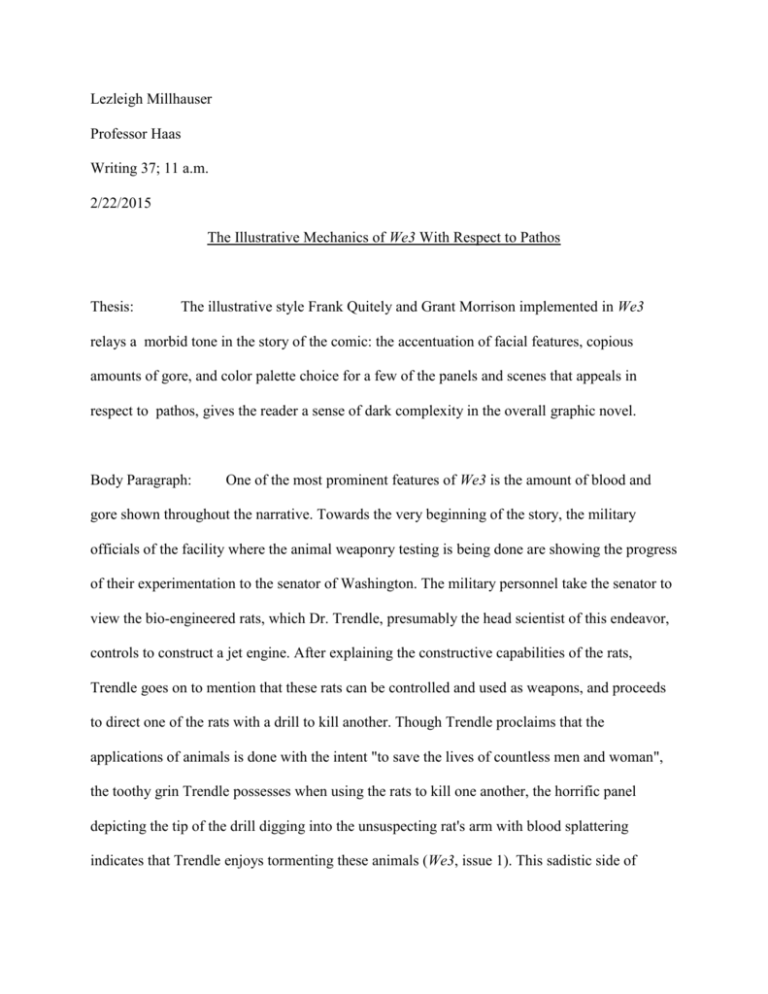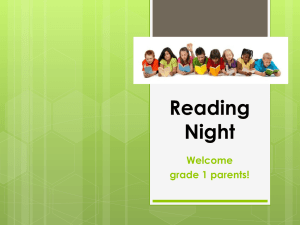File
advertisement

Lezleigh Millhauser Professor Haas Writing 37; 11 a.m. 2/22/2015 The Illustrative Mechanics of We3 With Respect to Pathos Thesis: The illustrative style Frank Quitely and Grant Morrison implemented in We3 relays a morbid tone in the story of the comic: the accentuation of facial features, copious amounts of gore, and color palette choice for a few of the panels and scenes that appeals in respect to pathos, gives the reader a sense of dark complexity in the overall graphic novel. Body Paragraph: One of the most prominent features of We3 is the amount of blood and gore shown throughout the narrative. Towards the very beginning of the story, the military officials of the facility where the animal weaponry testing is being done are showing the progress of their experimentation to the senator of Washington. The military personnel take the senator to view the bio-engineered rats, which Dr. Trendle, presumably the head scientist of this endeavor, controls to construct a jet engine. After explaining the constructive capabilities of the rats, Trendle goes on to mention that these rats can be controlled and used as weapons, and proceeds to direct one of the rats with a drill to kill another. Though Trendle proclaims that the applications of animals is done with the intent "to save the lives of countless men and woman", the toothy grin Trendle possesses when using the rats to kill one another, the horrific panel depicting the tip of the drill digging into the unsuspecting rat's arm with blood splattering indicates that Trendle enjoys tormenting these animals (We3, issue 1). This sadistic side of Trendle shown in the beginning of the issue immediately resonates with the reader, pointing out that these scientists are cruel and what they are doing is blatantly inhumane. This act of violence manipulates the emotions of the reader to hold contempt for the experimentation of animals as weapons, and for the scientists and people who support these actions. However, the We3 animal weapons are also a part of this rhetorical mechanic that Quitely implements. In issue 2, as the We3 animals are hiding from the military, they encounter the bioengineered rats that Dr. Trendle created, which are now being used to kill Tinker the cat and Bandit the dog. During this fight scene, there is a significant emphasis on the We3 animals killing the rats, such as Bandit having a rat's bloody carcass in his teeth and small rodent limbs flying everywhere. The violence committed by the animals reveals the grey area of morality the graphic novel presents, and gives the reader a sense of perplexity regarding which side to root for: The humans or the animals? In Lisa Brown's interview with Grant Morrison, the writer for We3, she inquired about how the reader is more sympathetic towards the animals, even after they are shown brutally killing humans and even their animal counterparts. Morrison goes on to explain that the reader understands that the reader understands and sympathizes with the We3 animals' suffering, and because of what they have endured, part of the reader wishes to see these animals survive. However, Morrison goes on to explain "it was important to portray them as real animals, capable of bloody violence when necessary" (Antennae, 84). The violence shown caused by both the humans and the animals in We3 leaves the reader slightly confused about who the traditional "good guy" of this comic is. Though the reader most likely understands the plight of the We3 animals, the complexity of the circumstances in the story are felt by the reader's uncertainty to sympathize more with the humans or the animal weapons in the narrative.









